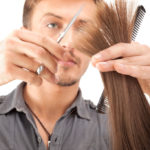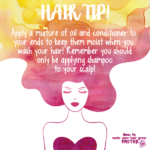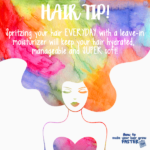Hello Lovelies,
As you all know, I believe that the science behind hair and its structure is the key to understanding your hair and how to make it grow longer. The most important piece of science that helped me master my hair and gave me the ability to manage my hair no matter its condition was pH. yes, pH, lovelies.
Now I know you’re thinking, what does pH have to do with hair care and growing long hair, and I’m here to tell you that it has everything to do with it and more. You see, hair, similar to skin, naturally has a slightly acidic pH level, and hair needs an acidic pH level to thrive. Before we move along, let’s review the pH scale just in case you’ve forgotten it.
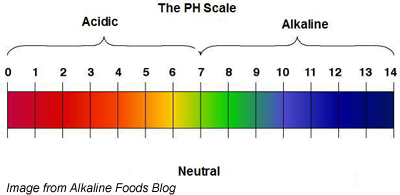
The pH scale is a scale that is used to measure how acidic or alkaline/basic a substance is. The pH scale ranges from 0 to 14. Substances with a pH level of 7 (the middle range of the pH scale) are considered neutral, substances that have a pH less than 7 are considered acidic, and substances with a pH reading greater than 7 are considered basic. Got it? Good (see, high school science would come in handy some day).
Human hair is happiest at a pH of 4 to 5.5, which is slightly acidic. Naturally you’d think that human hair would prefer to be neutral, but that isn’t the case. I thought this too, and I was shocked to find out that even water, with a pH of 7, is too alkaline for human hair (this is why hard water wreaks havoc on our hair).
When human hair comes into contact with alkaline substances, substances with a pH greater than 7, the cuticles of our hair responds by swelling and rising or opening up. If you’ve been reading up on hair structure, you know that raised cuticles are a bad thing. Raised cuticles equals porous hair, which is sort of like a revolving door. The hair will suck up moisture, but it’ll also have a hard time keeping moisture in, so that means your hair will be drier than usual, rough to the touch, tangle frequently, and be much more susceptible to damage and breakage.
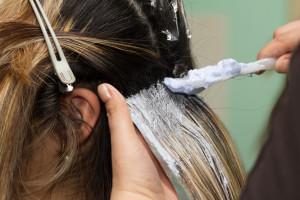 Many chemical processes like hair color and relaxers are alkaline in nature, meaning they have a high pH and will cause the hair shaft to swell. This is why people who color and relax their hair have to use special shampoos and other hair care products to counteract the high pH of the chemical processes they use; it’s to keep the cuticle closed and prevent the hair from becoming porous. The number one way to do this is via pH balancing, which is also known as sealing the cuticle.
Many chemical processes like hair color and relaxers are alkaline in nature, meaning they have a high pH and will cause the hair shaft to swell. This is why people who color and relax their hair have to use special shampoos and other hair care products to counteract the high pH of the chemical processes they use; it’s to keep the cuticle closed and prevent the hair from becoming porous. The number one way to do this is via pH balancing, which is also known as sealing the cuticle.
Now on the other end of the spectrum, when human hair comes into contact with lower pH substances, the cuticle reacts by contracting and laying flat. This is precisely what we want because a compact cuticle holds in moisture and is less likely to sustain damage. Additionally, when the cuticle is intact and flat, your hair just looks healthy, but back to pH.
So how do we pH balance the hair, simple? Use hair products that are within the range of 4 to 5.5 pH level. Well how do you know the pH level of your hair products? Well some hair product makers and manufacturers are getting savior with their labeling and they’re printing the pH of their product right on the packaging. However, if your products don’t have the pH on the label, you can find out the pH level via pH strips. You remember those from high school science classes, right? Those little strips where you swipe a little sample of the substance you’re testing across it and wait for the strip to change in color. Simply match the color to the pH indicator chart, which is usually printed on the package the pH strips comes in, and find out the pH.
Test the pH Level of Your Hair Products
Once you purchase or receive your pH strips in the mail, get every hair product you’ve ever used on your hair and test it. You may want to have a notebook handy so you can jot down the product’s name and its pH level. Once you’ve tested all of the products, organize them into two categories, one category for products with a pH higher than 7, and another category for products with a pH lower than 7.
If the products on the acidic side fall within the happy hair pH range of 4 to 5.5, these products are safe and perfect to use as is. If the products are above the happy hair pH level, you can still use them, but they need some “formulating” before they’re safe for use.
Alkaline products need an acidifying agent to bring their pH down to the happy hair pH range. Some of the acidifying agents I like to use are:
- Aloe Vera Juice (pH level of 3.0)
- Apple Cider Vinegar (pH level of 3.0)
- Juice of a lime or lemon (pH level of 2.0)
Now I recommend separating out your favorite moisturizers and hair products that are too alkaline from their original container and mixing them with acidifying agents in a separate bowl. Making your alkaline hair products will take a bit of trial and error because when it comes to pH, a little bit can equal a big change. I would only add an acidifying agent by the teaspoon, mix it into the alkaline product, then test it to see what the new pH is. If it’s falls within the happy hair range, perfect! If the new concoction is still too alkaline, add an additional teaspoon of your acidifying agent, mix the concoction, and test again. Keep doing this until the pH falls within the 4 to 5.5 range.
Now this may seem like too much to you, but if you want to turn your stubborn and unruly hair around and reach your long hair goals, it really isn’t. pH matters! It wasn’t until I practiced consistent pH balancing after every washing session with a special leave-in conditioner and with my other hair products that I experienced hair that was never dry, brittle to the touch, or dull, and for the first time, my hair actually grew past my bra strap.
Some Hair Types Need pH Balancing More than Others
 If your hair is curly or highly textured, you need pH balancing more than any other hair type. Sebum, the oil that our scalps produce, has a pH that falls within the happy range of 4 to 5.5. As you know, the curls and kinks found in certain hair textures makes it difficult for sebum to reach the full length of the hair, unlike straighter hair types where sebum reaches the ends of the hair with no problem. This is precisely why curlier hair textures tend to be drier, more susceptible to damage, and less likely to retain as much length in comparison straighter hair types. It’s due to the fact that the sebum is not coating the entire length of the hair so curlier hair textures aren’t pH balanced within the happy hair ranged. So where nature is lacking, science can pick up the slack.
If your hair is curly or highly textured, you need pH balancing more than any other hair type. Sebum, the oil that our scalps produce, has a pH that falls within the happy range of 4 to 5.5. As you know, the curls and kinks found in certain hair textures makes it difficult for sebum to reach the full length of the hair, unlike straighter hair types where sebum reaches the ends of the hair with no problem. This is precisely why curlier hair textures tend to be drier, more susceptible to damage, and less likely to retain as much length in comparison straighter hair types. It’s due to the fact that the sebum is not coating the entire length of the hair so curlier hair textures aren’t pH balanced within the happy hair ranged. So where nature is lacking, science can pick up the slack.
If you have curlier hair, especially if you have a relaxer, hair color, or any other type of chemical treatment, pH balancing is your friend. If your hair falls within the curly range, pH balancing will be the most important step to getting your hair healthy and under control.
